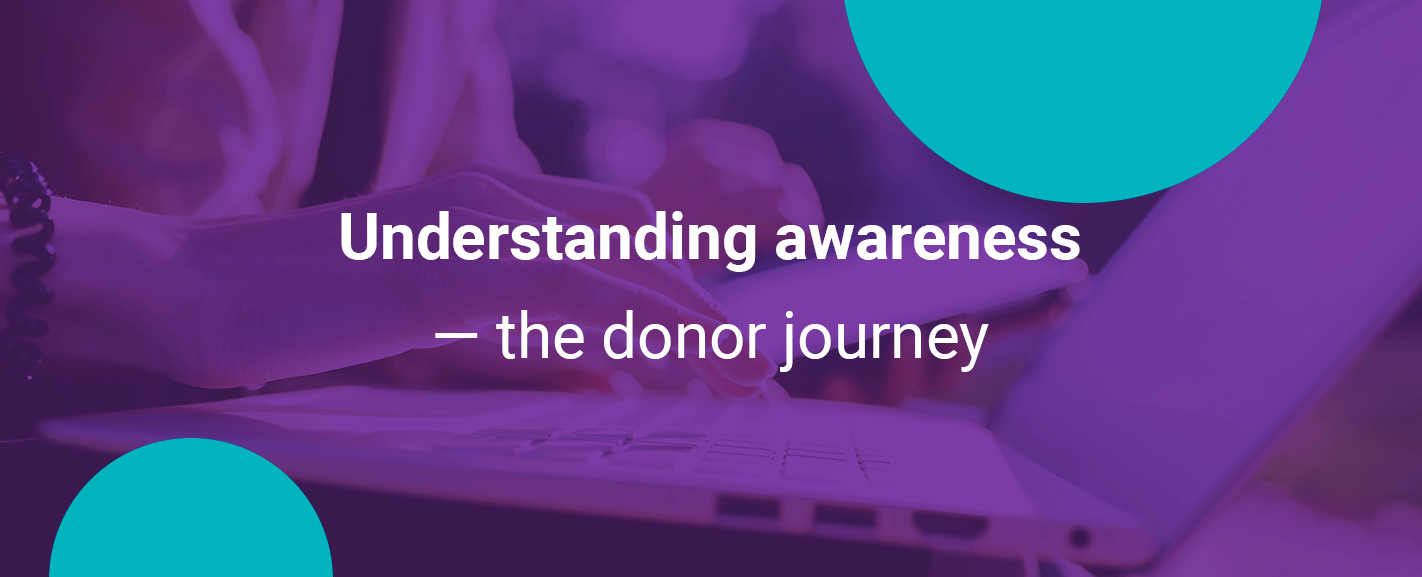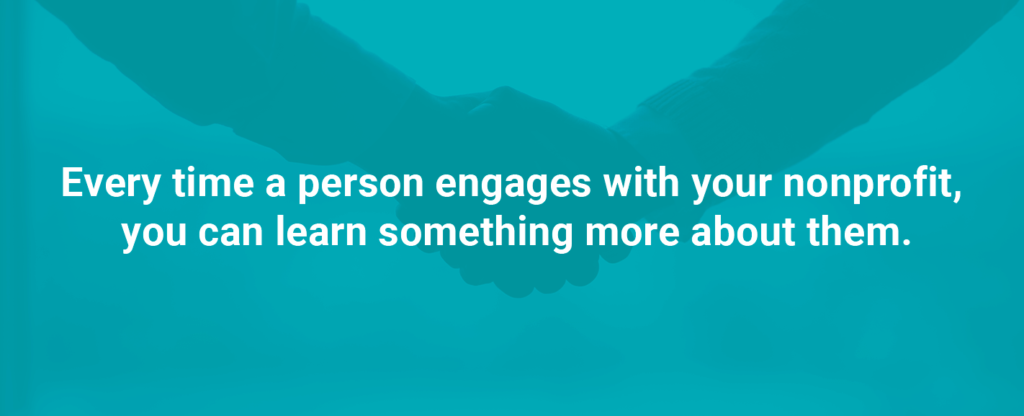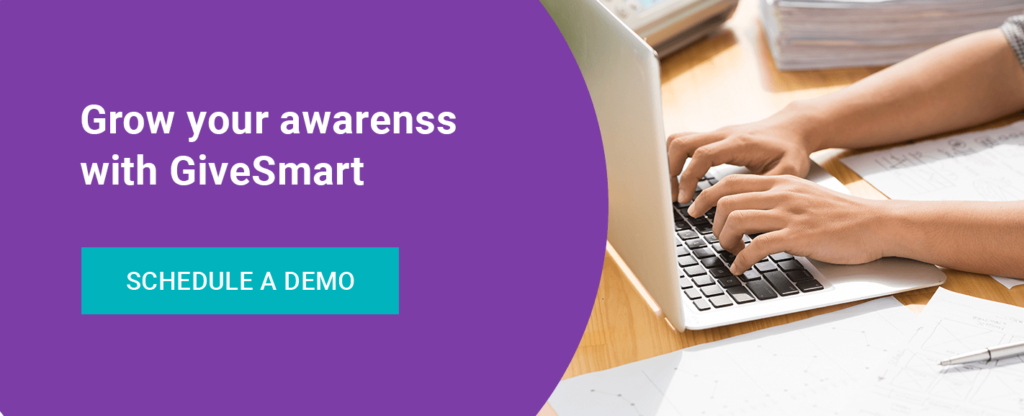Mar 29, 2022
Understanding awareness – the donor journey

Your donors are vital to your organization because they provide you with the funding and resources to serve your community and bring your mission to light. They also help spread the word about your organization and recruit other members and donors interested in your cause.
Your donors will act as representatives of your nonprofit and let others know that their donations are going to the right place. To help attract and retain donors, it’s critical to understand the donor journey and put yourself in their shoes. The donor journey represents the donor lifecycle — from finding your organization to donating and remaining loyal to your cause for years to come.
The stages of the donor journey
Understanding the donor journey will help you learn more about your donors and how, when, and why they give to your organization. Knowing more about your donors can make it easier for you to connect and engage with them — leading to more support in the future.
1. Awareness
In this article, we’ll focus on this first stage and how it influences donor engagement and your marketing strategies. Awareness is how well people know your nonprofit. The more awareness your organization has, the better chance of increasing your donor base.
To help more people learn about your nonprofit, you can use push and pull tactics to promote searchability and donor awareness. Push, or outbound, methods include paid advertising, cold-calling, trade shows, or any other means of getting the word out about your nonprofit. Pull, or inbound, methods focus on getting your nonprofit to pop up when someone is looking for related organizations or causes.
2. Consideration
The next stage in the donor journey is to communicate your values and purpose to the individual who has found your nonprofit. Think about how you can help them emotionally connect and engage with your organization over others in their community.
In the consideration stage, potential donors will research your nonprofit and determine if they want to be a part of your cause. You want to give your donors everything they should know about you and offer them as much information as possible. Consider the personal reasons why donors give and how your organization connects with them.
3. Decision-Making
By this stage, donors should decide if they want to give to your organization and spread the word about your mission. Once they’re in love with your nonprofit, you should make it easy for them to donate. Your donation buttons should be easily accessible at the top of your page so they can find them quickly. Add donation buttons in multiple places so it’s easy for donors to take action.
4. Evangelizing
The final stage of the donor journey is when you can start to rely on your donors to increase your brand awareness, recruit prospective donors, and share your nonprofits’ posts on social media to promote social fundraising.
Keep your donors updated and engage with them via email or text. Tell them about upcoming opportunities to encourage your loyal donor base to turn around and get their friends involved. You can give your donors some creative freedom and have them organize different campaigns and events to spread the word.
Putting yourself out there
When it comes to awareness, the most important element is becoming as visible and discoverable as possible for existing and potential donors. You can work on strengthening this through different strategies that promote your cause and keep the donor journey going.
Use social media platforms like Facebook, Twitter, and Instagram to increase your visibility and reach out to those interested in your cause. When you and your team go through the steps of the donor journey to gain a better understanding of their values, you can create better marketing and fundraising tools that take them through this cycle.
Develop personas for your donors
When marketing your nonprofit, consider the different groups and demographics that might connect with your organization to build a stronger relationship. Personas are similar to your target audience — they’re the ideal people who give to your nonprofit.

Using donor personas provides data that helps you work toward growing relationships with donors and your organization. Every time a person engages with your nonprofit, you can learn something more about them. When you collect and analyze donor data, you can narrow down your donor base and discover what inspires people to connect with your campaign.
Some basic demographic questions you can ask to come up with these personas include:
- How did they learn about your nonprofit?
- How do they like to engage?
- How do they like organizations to engage with them?
- What are they interested in?
You can go even deeper and ask any valuable, relevant questions that help you determine the type of persona that’s likely to engage with your organization. From there, you can adjust how you align your communication with them, whether you focus on certain social media platforms or produce particular content, from videos to written posts.
Nonprofit marketing tips and tricks
The most effective way to reach donors is through your marketing plan, so it’s important to keep up with nonprofit marketing techniques to help you reach donors.
1. Identify your goals
Your nonprofit marketing strategy helps you turn your mission and objectives into smaller, actionable steps. Your goal may be to raise more money or awareness, promote a specific campaign or encourage donors to volunteer.
Brainstorm with your team and identify and define a few ways to advance each goal. Consider different opportunities and ways you can share your content that keeps donors engaged and furthers your mission.
2. Know your audience
You must know your audience and understand what they’re looking for in your nonprofit. Your marketing will change based on who you’re talking to, so keep this in mind when creating content. Bringing in new donors, rallying existing donors, or calling for volunteers will have different messaging.
You can segment your lists into different personas to help you stay organized and tailor your communication. You can also look at your data to see where prospective donors often fall off the donor journey cycle and improve your retention strategies by discovering what they want to see.
3. Create key messages
Create key messages that encompass the information you want your audiences to hear and share about your nonprofit. These key messages will simplify your marketing and keep your organization aligned regardless of who promotes your organization.
Develop a personal approach to your message to help your audience feel emotionally connected, respond and act. Use language that’s consistent with your organization to maintain your brand.
4. Choose and implement marketing strategies
Once you have your goals and messages in mind, you can implement the marketing tactics to execute them. Will you pay for ads on social media, or craft posts and encourage viewers to share them? Will you focus your efforts on search engine optimization (SEO) for your organization’s website?
No matter which method you choose, always check that your tactics tie into your nonprofit’s marketing goals. You want to plan these strategies thoroughly to ensure they will positively impact your organization.
5. Analyze your performance
Use routine analysis and reporting to identify areas of improvement. You should also pay attention to your key performance indicators (KPIs) to help you measure organizational success. This information will help you determine your impact and allow you to continuously review and refine your strategies over time. KPIs for your nonprofit may include:
- Social media metrics: Look at what posts are getting the most impressions and engagement, from likes to comments and shares. Think about what made certain posts more successful and try those strategies in the future.
- Website statistics: Did a particular blog post do well and result in multiple conversions? Are visitors staying on your site for long periods, navigating to your donation page, and actually donating?
After conducting this analysis, always follow up with your donors and volunteers to request feedback and encourage them to stay active in your organization.
Grow your awareness with GiveSmart
At GiveSmart, we know how essential it is to keep donors engaged and enhance their experience. We offer several software solutions that can help you raise awareness for campaigns and fundraisers while helping you plan and manage events. Our technology lets your organization collect data and run analytics on your donors.
Our reporting tools also provide insights into many aspects of your nonprofit, so you can pinpoint the strategies that work best, along with many other features and integrations that accelerate your efforts. At GiveSmart, we want to help you create seamless fundraisers and build better connections with your donors simultaneously. Contact us today or request a free demo to see how we can help you meet your goals.

Related



